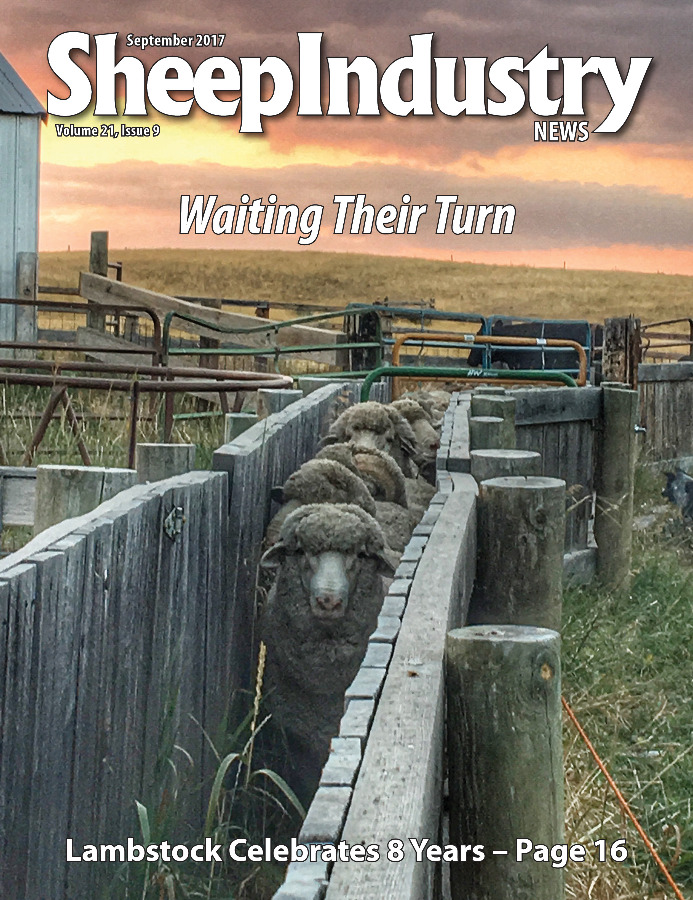
- September 2017
- President’s Notes
- AmericanWool.org Launches
- Priority 1: Parasite Resistance
- Lambstock 2017
- Kopanke Earns Scholarship
- Clements Perseveres in South Dakota
- Court Upholds Wyoming Grazing
- Industry Impact Study Available
- Committee Discusses H-2A
- Executive Board Meets in Park City
- Market Report
- The Last Word
Kopanke Earns Scholarship
Like many young girls who love animals, Jennifer Kopanke settled on becoming a veterinarian early in life. But she didn’t stop there, choosing to continue her education in a doctorate program at Colorado State University.
Her research into the bluetongue virus certainly played a role in her being selected the 2017 recipient of the Sheep Heritage Foundation Scholarship. The scholarship award is $3,000.
 “I was really glad to receive this scholarship,” Kopanke said from her current home in Fort Collins, Colo. “This will facilitate the research I’m doing on a very important topic for the sheep industry. I’m honored that the committee chose me to receive the scholarship.”
“I was really glad to receive this scholarship,” Kopanke said from her current home in Fort Collins, Colo. “This will facilitate the research I’m doing on a very important topic for the sheep industry. I’m honored that the committee chose me to receive the scholarship.”
The Oregon native grew up on Sauvie Island – a rural area just outside of Portland, Ore., that consists of half farm ground and half wildlife preserve. Kopanke got her start in sheep when a neighbor brought home two Polypay bum lambs from Oregon State University in the early 1990s.
“We just went from there,” she said. “We continued to build our flock and I did 4-H and showed sheep all the way through high school. We mostly have Suffolk crosses now. My parents still have the sheep, so I go back and help whenever I can.”
After high school, Kopanke headed to Willamette University in Salem, Ore., and majored in biology. She graduated with a bachelor’s degree in 2010 and followed with veterinary school at Washington State University in Pullman, Wash.
“As a kid, I don’t think I even really knew what it meant to be a veterinarian, but it was always something that I wanted to do,” she said. “As I continued my education and was exposed to science and medicine, it all became more of a reality for me.”
A move to Colorado followed, where Kopanke completed a residency in comparative medicine.
“It’s a dual degree/residency program, which is why I’m now working on my Ph.D.,” she said. “Now that I’m done with my residency, I can focus on my research – which is great.”
Kopanke expects to finish her Ph.D. program in May 2018, with plans to remain in the academic world that has been her home since graduating from high school.
“I’m in a great field right now because I love research,” she said. “But I also love the clinical side of veterinary medicine. I really enjoy where I’m at right now. When I’m done with my Ph.D., the goal will be to hopefully find a position that has a little bit of all of that. I want something that would allow me to have some clinical, some teaching and some research, so that’s probably a university position. But I’m open to other options, as well. After all these years in school, it’s about time to get a real job.”
For the moment, however, the bluetongue virus is her primary focus. She addressed her research in her scholarship application:
“Bluetongue virus is transmitted by biting midges and is readily spread to diverse animal populations. Sheep are highly susceptible to this virus, with some animals developing severe and often fatal disease. BTV is economically consequential. Direct losses from clinical disease, reproductive losses, animal movement restrictions and vaccination programs have cost billions of dollars in countries around the world. Understanding BTV is especially significant in North America, as several serotypes of the virus are endemic across the United States.
“Our work is important for its impacts on animal health and food security, in addition to its broader applications as a model for other emerging arthropod-borne viruses. Our research is also relevant for developing models to predict and simulate vector-borne pathogen spread and subsequent risk-mitigation and vaccination strategies.
“To date, my Ph.D. has been focused on characterizing BTV in Colorado through whole-genome sequencing of virus isolated from sentinel animals across the state. My work also places an emphasis on determining the specific genetic mutations and evolutionary processes that may contribute to BTV’s spread and ability to cause disease in ruminants. Our lab uses cutting-edge techniques, including next-generation sequencing, to answer these questions. Characterizing the complex genetic changes that are associated with bluetongue viral diversification enhances our understanding of important aspects of the virus’s overall ecology and transmission dynamics, and will be essential for future prevention strategies in domestic ruminant populations.”

